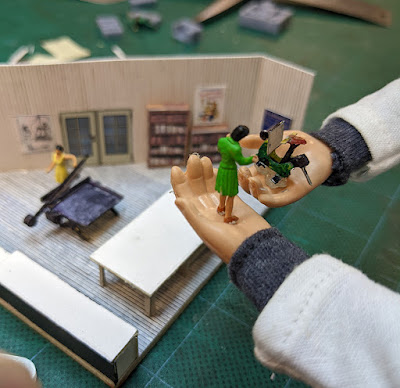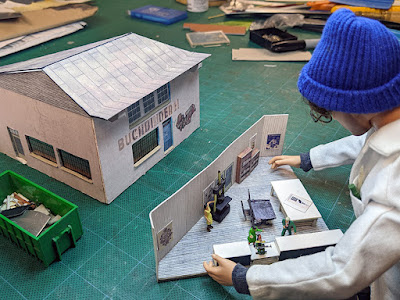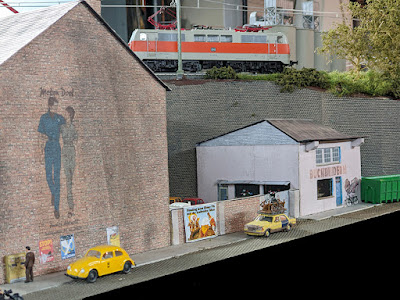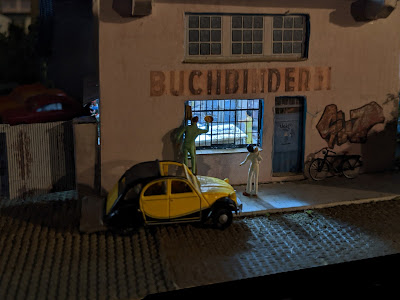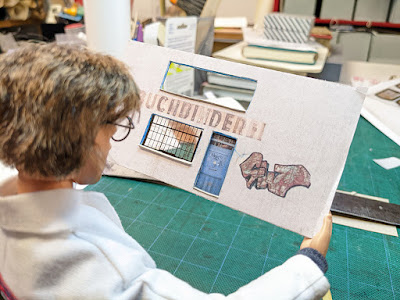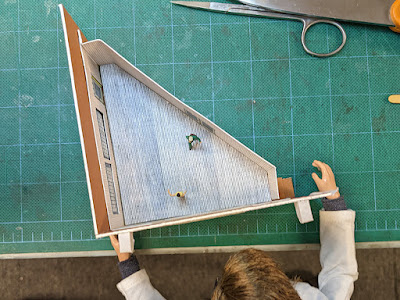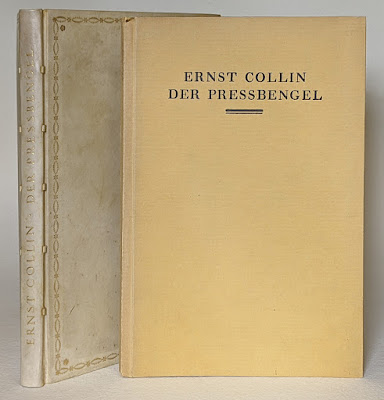Back in September 2021 I acquired a binding containing two small publications by Paul Kersten and 5 advertising leaflets for type holders and brass type made by Dornemann & Co. in Magdeburg. Two were written by Paul Kersten, two unattributed, and one is by Ernst Collin. Collin was no stranger to commercial work, also having written articles for Wilhelm Leo that were included in a calendar that they published annually.
.jpg) |
| P. Kersten. Geometrisches Zeichnen u Handvergoldung. The title is hand letter on the cloth. |
Works included in the binding are:
- Kersten, Paul. Geometrisches Zeichnen für Buchbinder. Verlag des Allgemeinen Anzeigers für Buchbindereien, Stuttgart, 1928. (Geometric Diagramming for Bookbinders)
- This text came out in a new edition in 1935 with one section rewritten to reflect the new power structure - how to properly represent the swastika. Perhaps a post for another day.
- Kersten, Paul. Lehrbuch der Handvergoldung: Eine Anleitung zum Selbsterlernen. Verlag von Wilhelm Knapp, Halle a. Saale, 1930. (Manual for Finishing: Instructions for learning on ones own)
Werbeschriften (Advertising leaflets):
- Kersten, Paul. Etwas über Schriftkästen. Dornemann & Co., Magdeburg, [s.d.] (About Typeholders)
- Kersten, Paul. Messing- oder Blei-Schriften. Werbeschrift Nr. 4. Dornemann & Co., Magdeburg, [s.d.] (Brass or Lead Type)
- [s.n.]. Schriftkästen. Dornemann & Co., Magdeburg, 1928.
- [s.n.]. Messingschrift-Giesserei Dornemann & Co., Magdeburg. Werbeschrift Nr. 8, Dornemann & Co., Magdeburg, [s.d.]. (Brass Type Foundery Dornemann & Co., Magdeburg - about the foundery) Written in German, French, English, Spanish. (Boîtes, Typeholders, Cajetínes Composteurs, Lettering Pallets)
- Collin, Ernst. Messingschriften für den Handvergolder. Werbeschrift Nr. 3, Dornemann & Co., Magdeburg, [s.d.]. (Brass Type for Gold Finishers)
While the German National Library has others of the series of Werbeschriften in its catalog, these do not appear...
Here the English page of Messingschrift-Giesserei Dornemann & Co. These sentiments are also reflected in Collin's leaflet.
Brass Type for Hand=Finishing!We are the only firm in Germany able to cast Brass Type for hand=tooling from instruments and matrices. This is the only process giving _bsolute guarantee for producing the highest grade type. Our Founts are famous for their clear face and deep cut even in the smallest sizes, the alignment of the letters is perfectly true and the height absolutely correct. The composition of metal used by us proves to have greatest resistance power and with care our type is practically indestructible, whilst owing to mass production our prices can be considered reasonable taking info consideration the high finish.Our brass type is known all over the globe where book finishers pride themselves in turning out good bindings and letterings, and both at home and abroad the superior quality of our productions are universally acknowledged. One of fhe best known craftsmen in Paris considers"The name of Dornemann is synonymous with perfection!"We are constantly endeavouring to keep our output up to the highest standard of efficiency as regards artistic and modern perfection, and our type will be found most durable. All goldfinishers requiring type, ornaments, and gilding tools for handlettering should apply fo us for samples and catalogues.
When I returned from my apprenticeship in Germany, I ordered a basic set of pallets and gouges for finishing from via the West German distributor for Dornemann, still in Magdeburg and in the DDR.
Dornemann also produced a set of pallets and gouges designed by Ignatz Wiemeler, one of the finest design binders, ever.
In 1987, pre-reunification the pallets were 229 and the gouges 285 Deutsch Marks. In 1991 I ordered the other set of gouges and the price had increased to 557 Deutsch Marks. For this Wessi, it would have been smarter to buy all in 1987, but who would have known the wall would come down 2 years later. All in all, good that it came down.
 |
| Looking east and at the building for the State Publisher of the DDR. This picture and the next were taken by me in November 1984. More from that visit and the one in December 1989 here. |
 |
| Looking over the wall. The image was taken with a telephoto. Between the Wall (Ebertstrasse) and the Staatsverlag (Wilhelmstrasse) was once Hitlers bunker... Now the "death strip" has been filled in with buildings, but just to the left of this picture is the Memorial to the Murdered Jews of Europe. |
History is everywhere, and Ernst Collin and his family were certainly a part of it on many levels.























